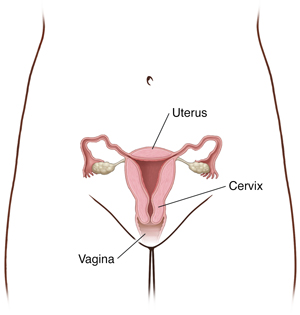What Is Cervical Cancer?
Cancer happens when cells in the body change and grow out of control. These cells can form lumps called tumors. Cancer that starts in cells of the cervix is called cervical cancer. The cervix is the lower end of the uterus. It connects the uterus to the vagina.
Cervical cancer can spread from the cervix to other parts of the body. This spread is called metastasis. The more cancer spreads, the harder it is to treat.

Types of cervical cancer
When cells in the cervix start to change and grow in ways that aren't normal, it's called dysplasia. Dysplasia isn't cancer, but it can become cancer if not treated.
There are 3 kinds of cervical cancer:
-
Squamous cell carcinoma. This starts in the thin, flat cells on the surface of the cervix. It's by far the most common kind of cervical cancer.
-
Adenocarcinoma. This starts in gland cells of the cervix.
-
Mixed carcinoma or adenosquamous carcinoma. This is cancer that's made up of both of the types listed above.
What causes cervical cancer?
In most women, cervical cancer is caused by the human papillomavirus (HPV). HPV infection is very common and often goes away on its own. But in some cases, over time, HPV infection may continue. And it may lead to cervical dysplasia and then to cervical cancer. HPV infection is strongly linked to cervical cancer. But it's important to know that most women with HPV don’t develop cervical cancer.
Other risk factors include:
-
Smoking
-
Being overweight
-
Long-term use of birth control pills (oral contraceptives)
-
Chlamydia infection (a sexually transmitted infection)
-
Having a weak immune system
-
Having 3 or more full-term pregnancies
-
Having a full-term pregnancy before age 17
-
Having a family history of cervical cancer (mother or sister had it)
Not all of these risk factors may directly cause cervical cancer. But they may be linked to other risk factors, like exposure to HPV, which does cause cervical cancer. Talk with your healthcare provider about your own risk for cervical cancer.
Can cervical cancer be prevented?
There are several ways to prevent cervical cancer.
-
Get screening tests. Regular screening with a Pap test and HPV test can help find cervical cell changes before they become cancer. Treating these changes can keep cancer from starting. Cervical cancer grows slowly. So regular testing can also help find this cancer early, when it's small and easier to treat.
-
Get the HPV vaccine. A vaccine can prevent HPV and HPV-linked cancers. It's given to both men and women. To work best, the vaccine should be given at or before age 11 or 12, before the first possible exposure to the virus. It's also recommended for everyone through age 26, if not vaccinated already. The vaccine is approved by the FDA up to age 45 for people who haven't been vaccinated. Ask your healthcare provider about the vaccine if you haven't had it.
-
Use condoms. Condoms can protect you from HPV exposure. They need to be used correctly, and used every time you have sex.
-
Don't smoke. Smoking has been linked to cervical precancer and cancer.
What are the symptoms of cervical cancer?
In early stages of cervical cancer, most women don't have any symptoms. As the tumor grows or the cancer spreads, the most common symptoms are:
-
Abnormal vaginal bleeding
-
Vaginal discharge
-
Pain during or bleeding after sex
These symptoms may seem like other things, such as an infection. See your healthcare provider if you have any of these symptoms.
How is cervical cancer diagnosed?
Cervical cancer is usually found during a screening Pap test. During a Pap test, cells are taken from a woman’s cervix and checked for changes that may be a sign of dysplasia or cancer. This can help find cervical cancer early, when it's easiest to treat. Get a Pap test as often as your healthcare provider suggests.
How is cervical cancer treated?
You and your healthcare provider will discuss a treatment plan that’s best for you. Options may include:
-
Surgery. The part of the cervix with cancer may be removed. Or the whole cervix and the uterus may be removed (total hysterectomy).
-
Radiation therapy. This uses strong energy rays to kill cancer cells.
-
Chemotherapy. This uses strong medicine to kill cancer cells. It may be used along with radiation therapy.
-
Targeted therapy. This uses medicines (not chemotherapy) that attack and kill cancer cells. But this treatment limits the damage to healthy cells. Targeted therapy is not yet used as a first treatment for cervical cancer. But it may be used if it comes back or spreads.